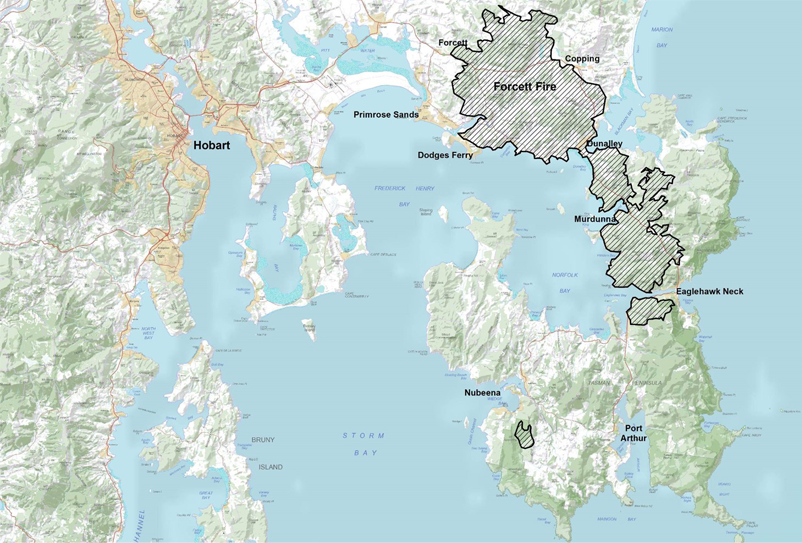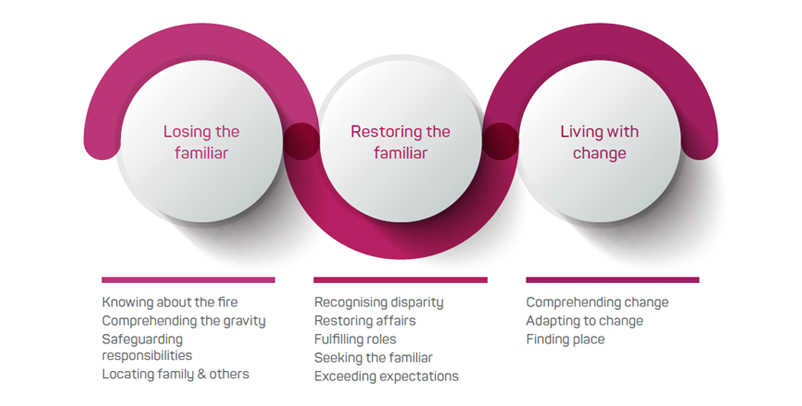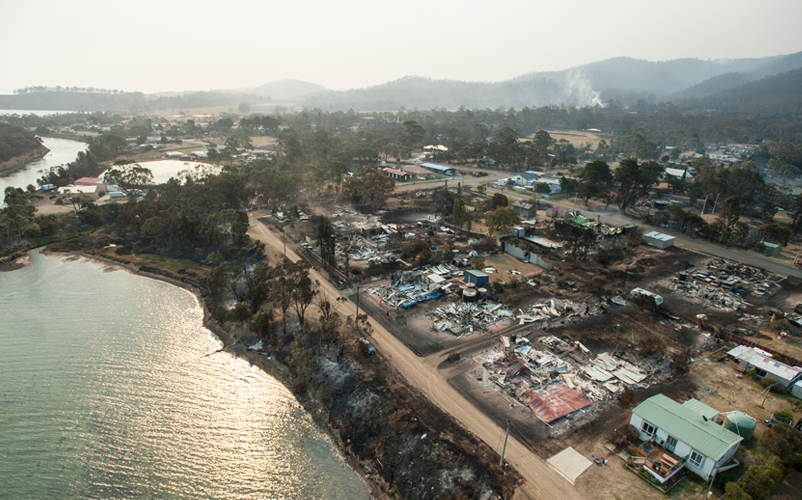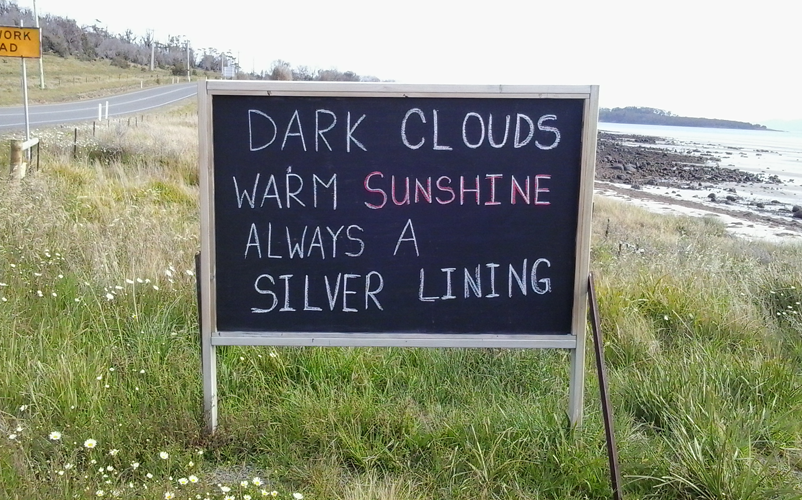This research examined how people directly affected by a catastrophic event respond to that event, individually and as a community. It shifts from concepts of ‘community-led’ or ‘recovery’ after an event to a more pragmatic view of community disaster recovery. A catastrophic bushfire near Forcett, in Tasmania’s south-east in 2013 is used to examine people’s dependence on community and place to help then navigate the event. A constructivist grounded theory approach was used to identify a model of ‘Navigating Uncertainty’. This covers three phases of ‘Losing the familiar’, ‘Restoring the familiar’ and ‘Living with change’. These phases illustrate how people experience the perilous situation where lives were threatened and homes, communities and livelihoods damaged or destroyed. In such situations, people’s decision-making and action are often underpinned by individual and collective values.
Introduction
On 4 January 2013, a fire started at Inala Road on the outskirts of Forcett, on the peninsular across from Hobart in Tasmania. The fire continued south along the Arthur Highway towards Port Arthur, devastating the small communities in its path. The Forest Fire Danger Rating and Forest Fire Danger Indices were Very High to Severe in the south-eastern districts. There were numerous fires burning across Tasmania including the fires in Forcett, Lake Repulse and Bicheno. By 3:00 pm, the fire rating reached Catastrophic level in five locations. The Forcett fire caused the most damage, burning 23,960 hectares and destroying 193 dwellings with another 186 buildings destroyed or damaged (Department of Premier and Cabinet 2013).
No deaths were attributed to this fire, however, the catastrophic fire conditions affected people’s lives significantly. Animals perished, homes, livelihoods and the vegetation were damaged or destroyed. Throughout the bushfire, many of the communities were inaccessible as roads were closed and remained closed for seven days. Residents who remained in the area after the fire carried out various activities. For example, one family that had retreated into the waters of the bay and taken shelter under a jetty, were transported by Ambulance volunteers to the Dunalley Hotel at around 11:00 pm. Many people, like this family, were cared for by local people. Makeshift beds were organised on the floor of the hotel and food and water were provided. A registration point was established on the hotel balcony to record the people who had evacuated to that location.
The next morning, despite the isolation and with the fire still burning, some community members located a barbeque and fed over 100 people. The local charity shop was accessed to provide clothes for people. Over the next five days, the hotel kitchen provided daily meals to residents and visitors to the area who were stranded by the event. Residents who had habitable dwellings accommodated neighbours, friends and relatives who had lost their homes.
It became evident that people who lived in these communities possessed a diverse range of skills, good knowledge and experience that they could muster and provide during this time. Although the fire threatened life and left a trail of destruction, social structure and processes became evident. A sense of governance built on communal norms, together with a strong connection to place and social processes, gave meaning and purpose. These social structures and processes are considered in this research.
Literature review
The literature review has been the topic of debate throughout the evolution of grounded theory. In constructivist grounded theory, the initial literature review provides a reflective account of the ideas exposed. It is the second review that integrates relevant existing knowledge with the new theory. The initial literature review presented in this paper considers social systems and coping.
The term ‘coping’ is used in the literature, however, despite its frequency, the term is complex especially when it comes to people’s wellbeing. Wisner and colleagues (2004) claim “coping is in essence a strategy reactive to events beyond the immediate control of the individual, household or ‘community’” (p.120). Handmer (2003) maintains that the capacity to cope and adapt to change is a valuable concept and a shift from vulnerability, which is often perceived as ‘the susceptibility to loss and the capacity to recover’ (p.56). The capacity to cope with the unforeseen or unanticipated could be considered as ‘pro-active adaptation’, hence, the struggles and activities of people affected by adverse circumstances and their ability to cope are often overlooked (Handmer 2003). As such, the capacity of a social system to ‘cope’ may remain unnoticed and understudied. Furthermore, consideration of vulnerability is often measured using resources within the context of socio-economic structures because it is perhaps easier to recognise by outside institutions (Wisner et al. 2004).
A critical aspect of coping is that when people’s circumstances deteriorate, an individual’s reaction may prove to be ineffective (Wisner et al. 2004). In the 1972 Buffalo Creek disaster, 132 million gallons of coal black water broke a makeshift dam and engulfed the ‘tightly knit’ community of 5000 people. It destroyed the homes of 4000 people and 125 people were killed. The catastrophic event significantly affected the community’s emotional shelter; ‘the surrounding community is stripped away and can no longer supply a base of support’ (Erikson 1976, p.154).

Figure 1: Map of Frederick Henry Bay and Norfolk Bay showing the extent of the fire on the western land areas, known as the Forcett fire.
Source: Tasmanian Government Department of Premier and Cabinet 2013
Methodology
This research project was approved by the RMIT University Science Engineering and Health, College Human Ethics Advisory Network.
This study involved 40 people from the small communities of Forcett, Copping, Boomer Bay, Dunalley, Connelly’s Marsh and Murdunna, as well as the towns of Bream Creek and Marion Bay. The study also included external support volunteers and representatives from local and state governments and non-government services.
A constructivist grounded theory method of analysis was used to gain an understanding of how people respond to the bushfire. The aim of grounded theory is to generate an original theory that is grounded in the data and not to impose a priori theory or framework. It is the theorising and interpretive work of people that results in a theory; interpretation developed from the researcher’s perspective.
Grounded theory studies often begin with sensitising concepts, described as tools that ‘provide a place to start inquiry, not to end it’ Charmaz 2014, p.31). In this study, the sensitising concepts ‘community-led recovery’ stimulated the initial data generation, however, it was important to remain flexible and open to participants’ experiences and views to allow the discrete storytelling of their involvement. A reflective account of data analysis that included how the data was transcribed and coded, and the strategies used, strengthened the analysis. This included theoretical sensitivity, memo writing and theoretical sampling that illustrated the technique and procedures used in the data analysis and category construction.
During analysis, the codes that best represented the multiple viewpoints, actions and experiences were used to build subcategories. Once the categories and their properties were defined and links made between categories, they were sorted and examined against the literature with inferences made about the empirical experience, which is the deductive part of grounded theory.
In this study, the word ‘navigating’ was used to define the ‘process’ that people pursued during the unaccustomed event. The word ‘uncertainty’ represents ‘context’ of the event and circumstances. ‘Navigating Uncertainty’ is an interpretive conceptual understanding of community members’ involvement in the Forcett fires of 2013.
Findings
The theoretical outcome of this research, ‘Navigating Uncertainty’ is built around community members’ main concerns and what they did to resolve those concerns. The findings imply that community members experienced three phases; ‘Losing the familiar’, ‘Restoring the familiar’ and ‘Living with change’.

Figure 1: The grounded theory of ‘Navigating Uncertainty’.
Losing the familiar
Leading up to the bushfire, the main concern that community members faced was the bushfire hazard, which diminished a context that was familiar, routine and safe. The ferocity of the bushfire created a level of uncertainty and disrupted their everyday activities.
Knowing about the fire
When community members became aware of the fire, their level of awareness was influenced by indications of the actual bushfire, the interpretation of cues and signs against their own reality and then were acted on. This included past bushfire experience, the weather conditions on the day and surrounding topography to determine a level of risk.
This study showed there were varying degrees of awareness, which were linked to actions. Some community members were aware of a fire but were blasé, believing the bushfire was not a threat and therefore were not concerned and payed little attention. Conversely, others were more active and assessed and acted on the fire threat by making predictions, using intuition, monitoring the event, planning and increasing their preparations.
Comprehending the gravity
Comprehending the gravity involved interpreting and reinterpreting what was happening to verify the seriousness of the fire hazard. The language used by community members to account for the fire behaviour illustrated their feelings of the experience. In this study, community members felt overwhelmed by the unpredictability of the fire’s behaviour; seeing ‘a ball of fire travelling across the water’, ‘fire jumping out of the sky’, or a ‘snowstorm of embers’. These words have a profound impact on the senses. Boylan, Cheek and Skinner (2013) noted that residents who chose to remain in the area ‘stated that they were not prepared for the ferocity, heat, noise and speed of the bushfire’ (p.33).
Safeguarding responsibilities
Safeguarding self, family and others was a priority and a high proportion of community members acted on their understanding of vulnerability and duty to others. This process involved checking that other residents had evacuated, were safe, or the knowledge of who was staying or leaving. A few community members knew areas they felt were safe and told others to seek shelter. They assembled in areas where there were groups of other people, fundamentally near the water, on the local jetties or on boats. Community members relied on advice from trusted local sources. For example, a local fisherman told one community member to watch the wind and the boats. If the boats changed direction, they recommended it would be time to leave.
Locating family and others
Communication during the event was hampered by the bushfire. Numerous community members who evacuated on advice from family, the police or of their own accord, thought they would be back ‘in no time’ and everything would be back to normal. When community members were separated from family and friends, their distress and anxiety increased. They conjured up scenarios, with many deliberating on memories of other events like the 1967 Tasmanian and 2009 Victorian Black Saturday bushfires where there was great loss of life. Staying connected was extremely important. Gibbs and colleagues (2016) show that separation from loved ones during and directly after fires is highly stressful and a risk factor in subsequent mental health problems.

Hot, windy conditions fanned up to 40 fires throughout Tasmania in 2013 with the main fire started near Forcett that caused significant damage to local townships, particularly Dunalley where more than half of the town’s buildings and a primary school were destroyed.
Image: Warren Frey
Restoring the familiar
During the bushfire, community members’ concerns were about the bushfire and the destruction, damage and disparity that directed their efforts on restoring everyday life. A sense of normality offered a level of certainty, stability and safety.
Recognising the disparity
Recognising the disparity entailed the comprehension of what had happened, the unfamiliar milieu, silence and devastation. Community members outside the fire zone struggled to grasp the information they received and yearned to know what had happened, which generated a powerful desire to see the burnt areas with their own eyes. This involved returning to the burnt-out areas to fully comprehend the extent of the information they had received, because hearing the detail didn’t suffice; it made no sense and was unbelievable. To view the setting helped make it factual and helped community members interpret the situation. They described this experience as if their home had been placed in a different setting because very little was familiar. The walk or drive down the main street of Dunalley was, for one community member, the most ‘bizarre ten minutes’ of their life.
Restoring affairs
Restoring affairs involved re-establishing interactions and the familiar systems and relationships, place and way of life. To return to place was important. Community members felt a strong desire to return and recreate networks. Community members who had experienced the event and trauma first-hand, cared for others who were distressed or required support. One community member witnessed the effects of trauma through their interactions with others. They recognised an impairment of decision-making and they felt this was due to shock. Decision-making was impaired or delayed. While some community members attended to personal requirements, others managed practical matters such as clearing roads of debris to give emergency vehicles access. Residents adjusted their actions to the identified demand by recognising problems, prioritising tasks and then matching their capabilities and the resources available.
Fulfilling roles
Fulfilling roles involved meeting a need, demand, desire or custom. This study showed this was matched to capability, capacity and available resources. Existing roles changed and community members undertook additional responsibilities that were determined by their changing priorities. The efforts required to manage the event often went beyond the capacity of community member’s normal existence, their day-to-day routine, role or usual duties.
Seeking the familiar
Many community members sought things that were familiar and valued seeing familiar faces, even the faces of residents whom they did not know but had seen. Some community members who lost homes chose to remain in the community close to extended family and to place. It was something they understood, and it was familiar. Others felt it was difficult to leave the area for work commitments. The community members whose homes were destroyed by fire yearned to return to place.
Exceeding expectations
Exceeding expectations involved the contribution of a large portion of self, to deal with the extra demands, moral obligations, changing roles and the added complexity of the event. Community efforts were a seven-day-a-week commitment and anytime of the day. The work often continued until the job was done. Priorities shifted and demands changed. The varying expectations for community members mirrored what was required; give that little bit more, juggle the extra job, make an effort, put in the hard yards. The extra demands generated by the fire were emotionally and physically demanding. This cumulative effect depleted energy and many people struggled with their emotions and felt exhausted. This study showed that much of this was kept private.
Living with change
Navigating such a significant life event defined each community member’s experience in its entirety; their meaning and approach, unique and personal. Their involvement in the event influenced the individual as well as the community’s recovery.
Comprehending change
Comprehending change involved reflecting on the overall event and its consequences and to attach and construct an interpretation. A few community members felt that the bushfire had exposed the best and the worst in people; egocentricity and altruism. Community members felt there was a common goal for a while and that it brought their sleepy villages together. Some recognised turning points when the altruistic behaviour and feeling of a common goal began to wane and previous lifestyles re-emerged. Residents’ lives were exposed visually. When financial and material aid surfaced, individual values that related to equity and the distribution of benefit caused fractures in the sense of common purpose.
Adapting to change
Adapting to change involved an individual’s approach or attitude to what was encountered. The position or stance community members adopted influenced how they adapted to change and moved forward. An individual’s perspective, and the subsequent emotions and behaviours that came with that, helped them with the process of living with change. Many survival skills used were attributed to life experiences such as camping, living in rural areas where electricity could be unreliable and the willingness to make do with what you have, along with a reliance on others.
Finding place
Finding place involved looking at the ‘bigger picture’ to factor in other aspects of a significant life event; acknowledging the loss, damage and trauma as well as the renaissances. Erikson (1994) researched communities affected by disasters and identified two forms of trauma:
- individual (a blow to the psyche)
- collective (a blow to the tissue of social life).
The enormity of these trauma experiences affects meaning and the world is looked at in new and different ways (Eyre 2006).
The Forcett fire forced community members to step outside their comfort zones to connect, help and support each other and appreciate humanity. It created opportunities for different relationships with others, developing friendships and healing disagreements and disparities. One community member pointed out how they were different from their neighbour but during the emergency they worked with them to clear adjacent properties to protect their homes. In this process, they got to know each other and are now good friends. Community members who were relatively new to the area believed that the bushfire had ‘sped up the processes’ of them being ‘accepted’ by the community. It was generally recognised that being directly involved contributed to the development of friendships, strengthened relationships and a sense of belonging. This process contributed to finding place, gaining hope for the future, validating their efforts and confirming why they live where they live.

Sign on the highway towards the bushfire-ravaged area.
Image: Fiona Jennings
Discussion
‘Navigating Uncertainty’ assists in understanding the disorientation and subsequent reorientation people experience after extreme events. The Forcett fire was a significant life event that disrupted people’s normal frameworks and social systems through the sudden loss of routine and familiar settings. Cox and Elah Perry (2011, p.400) note that ‘the illusion of permanence, predictability and stability that is established through routines and the structuring of familiarity was unmasked’.
Interestingly, these types of reactions to an unfamiliar environment appear to be comparable to the theory ‘culture shock’, a term founded in social and experimental psychology on cross-cultural transition and adaptation. The literature on the psychology of culture shock draws attention to the cognitive and behavioural outcomes when people are suddenly exposed to a completely unfamiliar setting and feel largely overwhelmed by it. People may experience responses such as confusion, anxiety, bewilderment and disorientation. The earlier formations of culture shock were regarded as a ‘negative, passive reaction to a set of noxious circumstances’ (Ward, Bochner & Furnham 2003, p.270). Over time, these theories have evolved and people’s reactions to unfamiliar cultural environments is recognised as an active process in dealing with change (Ward, Bochner & Furnham 2003).
In the Forcett fire, normative systems that were drawn on were valued by residents. Residents valued opportunities to connect with people they knew or were familiar with in places they were accustomed to. The uncertainty generated by the bushfire disrupted people’s normative frameworks, which intensified the significance of familiarity. The disruption to normality meant personal relationships and shared histories became paramount during disorder (Ingold 2005).
The psychological and social processes provided meaning and purpose in a context of uncertainty and disruption, which contributed to the structures and processes that supported social stability. This happened at multiple levels of individual, family, group and community levels. There was meaning in the rebuilding of physical structures as it was about restoring familiarity, routine life, the sense of community, culture and traditional practices that provided certainty and social stability. Contemporary mental health literature has described recovery as a natural process of self-righting where people generally, unconsciously, act on the ‘difficulties and distress that interrupt the status quo of daily life’ (Australian Health Ministers’ Advisory Council 2013, p.21).
Implications
Findings from this study offer implications relevant to people living in fire-prone areas as well as emergency management planners. ‘Navigating Uncertainty’ illustrates three phases that encapsulate before, during and after. The properties ‘comprehending the gravity’, ‘recognising the disparity’ and ‘comprehending change’ demonstrate the active process of adapting to change. The findings assist in understanding how people directly affected respond to new and unresolved problems during a disaster event.
Limitations
A limitation on this study is the length of time that has elapsed between the Forcett bushfires in January 2013 and the interviews, which were conducted in
August 2015.
Conclusion
This study aimed to understand the experiences and perspectives of people living in the small communities affected by the Forcett bushfire in 2013. A constructivist grounded theory method was used to construct an interpretive understanding of the inherent psychological and social processes employed to deal with the event. A grounded theory method underpinned by symbolic interactionism assisted in preserving participants’ language, actions and meaning throughout the research. This study found that under massive disruption residents relied on processes and systems that were familiar to them that fostered a sense of stability and helped sustain them through a period of uncertainty and change. This knowledge enhances understanding of community disaster recovery.


